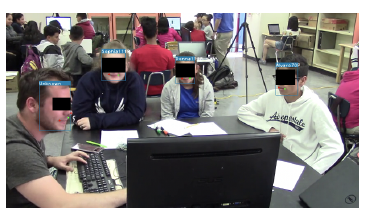About
This project will use a mixed methods research design to study whether and how computer programming supports the teaching and learning of mathematical content; whether and how the use of the bilingual curricula support teachers’ interactions with Latinx students; whether and how the curricula support Latinx and emergent bilingual students’ mathematics learning; and whether changes occurred in middle school students’ attitudes and learning, among other outcomes. The project will employ qualitative analyses of transcripts from interviews with middle school teachers, undergraduate facilitators, and middle school student facilitators; teaching documents such as lesson plans; video-recordings of classroom observations and professional development sessions; and student work. It will also employ quantitative analysis of pre- and post-measures of attitudes and learning in mathematics. In addition to sharing the curricula on a public website, the project will result in video tutorials that will support online and offline class delivery for middle school mathematics teachers with examples of teacher-adapted materials. Empirical research and implications for practitioners will be disseminated widely in peer-reviewed journals and professional conferences.
Publications
Website
Book Chapters
- LópezLeiva, C., Celedón-Pattichis, S., & Pattichis, M. S. (2020). Participation in the Advancing Out-of-School Learning in Mathematics and Engineering (AOLME) project: Supporting middle school Latinas’ bilingual and STEM identities. In B. Polnick & B. Irby (Eds.), Women of color in STEM: Navigating the waters of public schools. Charlotte, NC: Information Age Publishing.
Published Conference Proceedings
- Tapia, L.S., Gomez, A., Esparza, M., Jatla, V., Pattichis, M.S., Celedón-Pattichis, S., and LópezLeiva, C., “Bilingual Speech Recognition by Estimating Speaker Geometry from Video Data,”The 19th International Conference on Computer Analysis of Images and Patterns (CAIP), p. 79-89, 2021.
- Shi, W., Pattichis, M.S., Celedón-Pattichis, S., and LópezLeiva, C., “Talking Detection in Collaborative Learning Environments,” The 19th International Conference on Computer Analysis of Images and Patterns (CAIP), pp. 242-251, 2021.
- Tran, P., Pattichis, M.S., Celedón-Pattichis, S., and LópezLeiva, C., “Facial Recognition in Collaborative Learning Videos,” The 19th International Conference on Computer Analysis of Images and Patterns (CAIP), pp. 252-261, 2021.
- Teeparthi, S., Jatla, V., Pattichis, M.S., Celedón-Pattichis, S., and LópezLeiva, C., “Fast Hand Detection in Collaborative Learning Environments,” The 19th International Conference on Computer Analysis of Images and Patterns (CAIP), pp. 445-454, 2021.
- Shi, W., Pattichis, M.S., Celedón-Pattichis, S., and LópezLeiva, C., “Person Detection in Collaborative Group Learning Environments Using Multiple Representations,” 2021 Asilomar Conference on Signals, Systems, and Computers.
- Jatla, V., Teeparthi, S., Pattichis, M.S., Celedón-Pattichis, S., and LópezLeiva, C., “Long-term Human Video Activity Quantification of Student Participation,” invited in 2021 Asilomar Conference on Signals, Systems, and Computers.
- Tapia, L.S., Pattichis, M.S., Celedón-Pattichis, S., and LópezLeiva, C., “The Importance of the Instantaneous Phase for Face Detection using Simple Convolutional Neural Networks,” IEEE Southwest Symposium on Image Analysis and Interpretation, pp. 1-4, 2020.
- Carranza, C., Llamocca, D., and Pattichis, M.S., “Fast and Scalable 2D Convolutions and Crosscorrelations for Processing Image Databases and Videos on CPUs,” IEEE Southwest Symposium on Image Analysis and Interpretation, pp. 70-73, 2020.
Refereed Journal Article
Refereed Papers/Presentations at International/National Professional Meetings
Theses

Long Term Object Detection and Tracking in Collaborative Learning Environments
This thesis contributes robust methods for computer keyboard detection, tracking, and
student hand detection. For hand detection, the thesis integrates object detection
with clustering and time-projections for accurate, long-term assessment of student
participation. The hand detection method was integrated into a writing detection
system and can also be used for later research on recognizing student gestures.
arXiv

Fast Video-based Face Recognition in Collaborative Learning Environments
The thesis's goal is to develop a fast method for face recognition in digital videos that is applicable to large datasets.
The thesis introduces several methods to address the problems associated with video face recognition.
The thesis develops the AOLME dataset of 138 student faces (81 boys and 57 girls) of ages 10 to 14, who are predominantly Latina/o students.
Compared to the baseline method, the final optimized method resulted in fast recognition times with
significant improvements in face recognition accuracy. Using face prototype sampling only, the proposed method achieved
an accuracy of 71.8% compared to 62.3% for the baseline system, while running 11.6 times faster.
arXiv